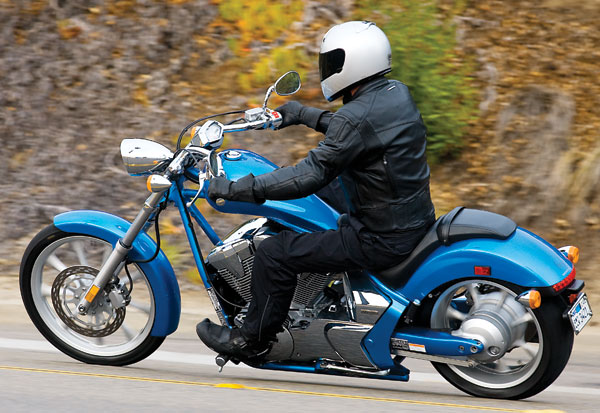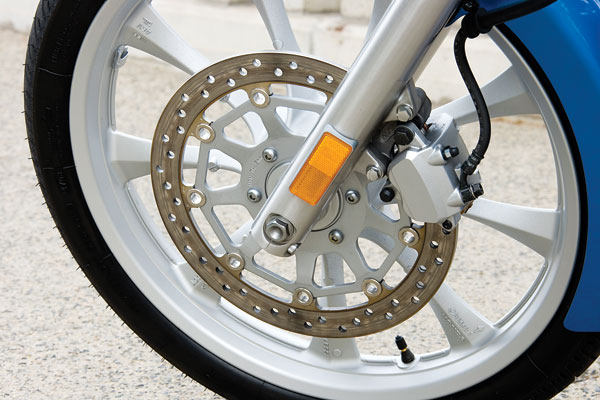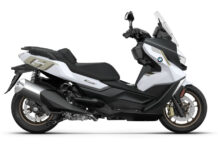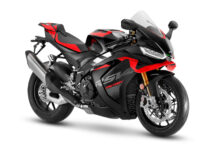
In the world of cruiser motorcycles, individualization is key. Everyone wants a bike that—when they see it parked outside a restaurant, shop or watering hole—will cause other riders to say, “Hey, that’s (your name here’s) bike!” There’s not another one like it, because it expresses your personality and individuality. Many of us want our bikes to express a creative, cool persona that identifies us to the world.
That’s what Honda had in mind when it designed the Fury, a bike that resembles a radical $30,000-$40,000 chopper, but works and runs like a Honda—which is a compliment indeed. Instead, the Fury is an early-release 2010 model that prices out at just $12,999 and, unlike that true custom chopper, will not present its owner with a never-ending horror of mismatched parts, vibration, engine noise, ill handling or lack of reliability.
The engine is set into a new tubular-steel frame that, with a cast 21-inch front wheel and a fat 18-inch rear, gives it a squat-in-the-rear, airy-in-the-front stance. To make it look like a chopper, Honda gave it a 71.2-inch wheelbase and rake/trail figures of 38 degrees/4.4 inches. By the way, that’s the longest wheelbase Honda has ever put on a motorcycle. Power is delivered to the rear wheel through a five-speed transmission and nicely integrated driveshaft.

First, the obvious question: Why did Honda choose to base its most radical machine on the VTX1300 rather than the more massive VTX1800? At the Fury’s intro a Honda spokesperson explained that over the years the little brother has outsold its big brother to the point that the 1800 has been dropped from the lineup for 2009.
Also, a chopper-style bike demands clear, uncluttered lines and the 1300 required a less voluminous airbox and exhaust system, and uses a smaller radiator that can be more readily hidden between the frame’s downtubes. Honda points out that in performing its sleight-of-hand tricks it hid the radiator hose beneath the front valve cover, and during the Fury’s development constantly juggled the shape of the tank along with its relation to the handlebar to maintain proper clearance between them. For a cleaner look and to better follow the contour of the rear fender they chose an LED taillight and hid the fender stays from sight. Those exposed frame rails give the bike an elemental appearance, and its frame shares no parts whatsoever with other VTX1300 frames.
Fire it up and the Fury engine has a nice mellow bark, muted to meet legal standards. Throw a leg over and the low seat (26.7 inches from the pavement) is nicely padded and dished, as the tiller-style handlebar and forward foot controls induce the rider into a forward lean—which may give shorter riders a bit of a reach. The injection works well, except for an occasional stutter right off idle if you don’t give it quite enough gas. When you’re on the gas hard, though, the Fury produces a more aggressive bark that is more in keeping with its appearance.

With a chopper one expects a rough-and-tumble machine that the rider will be fighting all the way in terms of comfort, seating position and how the controls work, but the Fury’s function is more reminiscent of how butter spreads on warm bread. Shifting is smooth, and clutch pull moderate. The suspension consists of a fork with a pair of nonadjustable 45mm tubes having 4.0 inches of travel, and a single rear shock with adjustable rebound damping and five-position spring preload. The ride is well controlled over small bumps and ripples, but with only 3.7 inches of travel the rear suspension will sucker punch the rider over potholes and abrupt bumps.
Strapped to the Jett Tunin Dynojet dyno the VT13VX Fury turned out 56 horsepower at the rear wheel at just 4,300 rpm, but a more respectable 71.2 lb-ft of torque at 3,600 rpm. This is not a lot of output, and performance is further muted by the fact that the bike weighs 663 pounds wet. A Gross Vehicle Weight Rating (GVWR) of only 988 pounds leaves a load capacity of just 325 pounds, which means that your 240-pound bro “Tiny” won’t likely be able to take his favorite squeeze along for a ride on the Fury unless she’s…tiny. Or she may decide to stay home as the passenger section of the seat is very firm and slopes rearward, giving the passenger the impression she is sliding off the back.
Yeah, we know, for styling purposes a chopper needs a big, ol’ fat rear tire, but rather than the now-popular 240-series rear skin (which makes the bike much harder to turn) Honda has equipped the Fury with only a chubby (but not outright fat) 200-series donut. Still, with that long wheelbase and kicked-out rake and trail the Fury steers in a leisurely manner, does not lean readily and will require a bit of forcefulness and body English to get it around slow corners. Get it into a turn fast, lean it appropriately and that side’s footpeg will soon be clattering along the pavement for lack of cornering clearance.

For brakes Honda bolted on a 336mm front disc rotor hugged by a twin-piston caliper, and a 296mm rear disc with a single-piston version. Stopping power is adequate, but unimpressive. We’d be more comfortable with a bit more braking force, especially in the front. The brakes on the base models are conventional, but later this year Honda will bring in a model with anti-lock and combined/linked brakes ($13,999); the bike will only be available in black.
The Fury is relatively light for a big-displacement stock cruiser, but part of that lightness comes from the fact that many of its parts (fenders, and chromed items such as the headlight shell, turn signals, instrument nacelle, valve covers, side covers and most engine covers) are plastic. On the one hand a rider expects a chopper to be hard-nosed and “real steel,” but on the other the use of plastic helps control price and weight. Another compromise is that, though stylish, that sculpted fuel tank holds but 3.4 gallons, and at the 42.4 mpg that we experienced the bike will have a practical range of just 144 miles, or just around 100 miles till the low-fuel warning light begins to glow.
Honda understands that you want your bike to be recognized when it’s parked outside the roadhouse, and offers a fair number of accessories for the Fury including various seats, a low sissy bar and pad, chromed rear fender panel for that solo seat look, and a color-matched chin spoiler. There’s also a flyscreen, front leather tool pouch and braided lines and hoses for the clutch, brakes and throttle. No luggage will be offered though as, according to a Honda spokesperson, the Fury is defined as a day tripper.
 The Fury certainly packs a lot of style and breaks new ground for Honda. It also garnered a great deal of attention wherever we rode it, and other riders often came up to ask about it. It’s relatively refined and comfortable, but also has some minuses. With just 56 horsepower it’s not going to ripple any asphalt, and we’ve already talked about its limited range. While it certainly is dramatically styled, that radiator with plastic grille won’t win you any high-fives down at the custom show, nor will all the plastic covers and bodywork.
The Fury certainly packs a lot of style and breaks new ground for Honda. It also garnered a great deal of attention wherever we rode it, and other riders often came up to ask about it. It’s relatively refined and comfortable, but also has some minuses. With just 56 horsepower it’s not going to ripple any asphalt, and we’ve already talked about its limited range. While it certainly is dramatically styled, that radiator with plastic grille won’t win you any high-fives down at the custom show, nor will all the plastic covers and bodywork.
The Fury is available for $12,999 in Ultra Blue Metallic, Black, Metallic Silver, Dark Red Metallic, or it’s $13,499 in Matte Silver Metallic; the Black-only ABS model is $13,999. For comparison purposes note that the much more conventional VTX1300C with its bobbed fenders is priced at $10,199, and the full-fendered R-model is $100 more. Whether a totally custom-look “chopper” that’s been civilized by Honda is worth an additional $2,800 over a conventional bike is a decision we’ll leave in your capable hands.
In a sense the Fury is a rolling contradiction. From its squat rump through its long, sculpted tank and exposed frame rails it screams “custom chopper,” but it’s a factory bike. With its slim radiator hidden between frame rails and that big, chromed V-twin engine bulging like a flexed muscle past its slim frame one expects a raucous exhaust note, but the Fury doesn’t sound like a custom and is quite civilized. It looks like it should be uncomfortable, but it really isn’t—for the rider. Overall it’s very nicely done, and does not require $30,000, niggling problems with fit and finish, nor (if you watch certain TV shows) putting up with the antics of Paulie and Paul Sr. for you to bring it on home. And that’s the “factory” part we like best.
2010 Honda VT13VX Fury Specifications
Base Price: $12,999
Warranty: 1 year, unltd. miles
Website: powersports.honda.com
ENGINE
Type: Liquid-cooled, transverse 52-degree V-twin
Displacement: 1,312cc
Bore x Stroke: 89.5mm x 104.3mm
Compression Ratio: 9.2:1
Valve Train: SOHC, three valves per cyl.
Valve Adj. Interval: First 600, then every 8,000 miles
Fuel Delivery: PGM-FI w/ single 38mm throttle body
Lubrication System: Wet sump, 3.7-qt. cap.
Transmission: 5-speed, cable-actuated wet clutch
Final Drive: Shaft
ELECTRICAL
Ignition: Digital, 2 spark plugs per cylinder
Charging Output: 381 watts max.
Battery: 12V 11AH
CHASSIS
Frame: Tubular steel double cradle w/ steel swingarm
Wheelbase: 71.2 in.
Rake/Trail: 38.0 degrees/4.4 in.
Seat Height: 26.7 in.
Suspension, Front: 45mm stanchions, 4.0-in. travel, no adj.
Rear: Single shock, adj. for spring preload and rebound damping, 3.7-in. travel
Brakes, Front: Single 336mm disc w/ 2-piston pin-slide caliper
Rear: Single 296mm disc w/ 1-piston pin-slide caliper
Wheels, Front: Cast, 3.00 x 21 in.
Rear: Cast, 7.0 x 18 in.
Tires, Front: 90/90-21
Rear: 200/50-18
Wet Weight: 663 lbs.
Load Capacity: 325 lbs.
GVWR: 988 lbs.
PERFORMANCE
Fuel Capacity: 3.4 gals., last 0.8 gal. warning light on
MPG: 87 octane min. (low/avg/high) 41.3/42.4/43.4
Estimated Range: 144 miles








